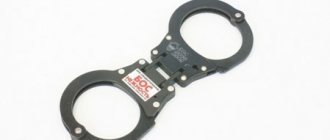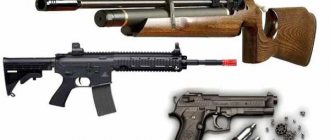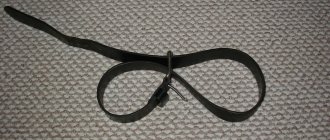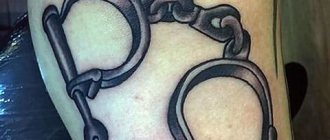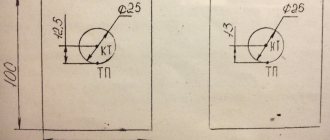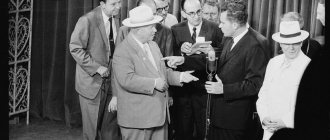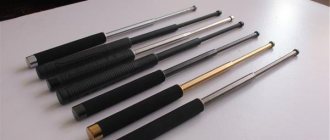How long are handcuffs worn in winter and summer?
At first I tried to look for relevant information on the Internet, but everywhere there were a lot of contradictory messages, some kind of confusion and inaccuracies.
But I would like to receive a clear and complete answer from a reliable source.
2. if civilians are prohibited from wearing handcuffs, then what kind of liability is provided for this (it is advisable to indicate the relevant articles and laws). What actions does a police officer have the right to take if he discovers handcuffs during a personal search if the citizen has not committed any offenses?
That was not the question. They are interested in the actions of the patrol officers who find handcuffs on a person. It’s clear that we are talking about legal behavior, I just want to understand whether they have the right to “seize” them, or whether this will be a violation with all the ensuing consequences. For example, I want to give a friend handcuffs for his birthday purely for fun) before that I gave him a baseball bat)
Handcuffs are classified as “ special means”
"! Use the “search engine” with the question “List of special means”!
hmm, well, here I come to what I had at the beginning)
ok, thanks everyone anyway, I’ll try to look for this list of special means and the order of the Ministry of Internal Affairs.
I'll report the results here.
PS, what about bracelets? In general, I don’t have any urgent need to carry them with me, I just want to find out the legal issue, so to speak. anything happens in life
The main question is what are BRs needed for? Knitting villains for sex, or for show-off?
I always carry a tightening plastic clamp for the CV joint in my car. Convenient, lightweight and has nothing to do with special equipment. I recommend it to the riot police. One minus is disposable. But it costs a penny.
Source
How to tie a girl with a rope: safety precautions
Don't tie the rope too tight
Two fingers should be placed between the rope and the girl's skin. The goal is to restrain her movements, not to cut off her circulation.
If the rope is likely to get wet (it's hot in the room, you're both sweating, you're using cotton rope), then leave even more space.
Constantly check if everything is fine
Periodically ask the girl how she is feeling and check the areas of skin in contact with the rope - if the skin turns white or blue, stop the practice immediately, bandage or remove the rope.
Never tie a rope in such a way that it could limit your ability to breathe.
In no case. We think there is no need to explain this point: a threat to life is not a toy.
Never leave someone tied up alone
Even if you need to go to the toilet for a minute. Anything can happen in life - just imagine what will happen if you suddenly feel ill or lose consciousness.
Keep flat medical scissors near you
In case the girl needs to be quickly released.
rules for using handcuffs
“Continuous handcuffing is allowed for no more than 2 hours, after which they are removed for up to 15 minutes.”
Please tell me what documents this norm is regulated by, I would be grateful for links to documents
Who uses special facilities? The gun law doesn't say anything at all about handcuffs. I don’t think they are often used by private detectives and security guards. The police law does not say anything about the duration of use. Article 14. Use of special means
Police officers have the right to use special means available to the police in the following cases: 2) to suppress resistance provided to a police officer; 3) to detain a person caught committing a crime against life, health or property and trying to escape; 5) to deliver detained persons to the police, escort and protect detainees, as well as persons subjected to administrative arrest and taken into custody, when their behavior gives reason to believe that they can escape or cause harm to others or themselves or resist a police officer; It is prohibited to use special means against women with visible signs of pregnancy, persons with obvious signs of disability and minors, except in cases of armed resistance, a group or other attack that threatens the life and health of people, as well as when suppressing illegal meetings, rallies, street processions and demonstrations of a non-violent nature that do not disrupt the work of transport, communications, and organizations. At the same time, it is prohibited to arm the police with special means that cause excessively severe injuries or serve as a source of unjustified risk.
Appendix No. 4 to the Decree of the Government of the Russian Federation of August 14, 1992 No. 587
RULES FOR THE USE OF SPECIAL EQUIPMENT BY PRIVATE DETECTIVES AND GUARDS
Features of the use of certain types of special means 11. Handcuffs. Periodic (at least once every two hours) check of the locking condition of the locks is required.
Source
How to make a device with your own hands
There are several options for making handcuffs from materials on hand. To understand the manufacturing principle, you should consider the most popular ones. These are improvised handcuffs made from an ordinary trouser belt and clothesline: these are the materials that should be considered the most durable and affordable.
From a trouser belt
The most popular option for making handcuffs yourself is the option from a regular trouser belt. For this purpose, a belt is used that is sufficiently wide and provides the necessary fixation on the hands. It is recommended to use a belt that is not smooth or varnished to prevent your hands from slipping into the loops.
The main idea of the technique is to fix the hands as rigidly as possible.
According to reviews from those who have tried this technique, creating two loops that cross each other, this type of homemade handcuffs is not considered reliable: with narrow hands, with some effort, simply widen the loops to the required width and free your hands.
A more effective method is to position the belt in such a way that the hands are placed inside two belt loops, which are located one inside the other. In this case, after placing the hands inside these loops, the belt is fastened with a buckle, which gives the greatest rigidity to the resulting connection.
From a clothesline
To make handcuffs you will need about 60 cm of rope, which you can buy at a hardware store. They have a high degree of strength, are durable and affordable.
The scheme for making homemade handcuffs is as follows:
- make two adjacent loops in the central part of the handcuffs;
- Now you should thread the second one into one of the loops - this will create a knot in the middle of the rope and two loops at the edges, which will become handcuffs in the final version;
- The attacker's hands are inserted into both loops, which are then tightened, and the ends of the rope secure the handcuffs around the hands and forearms.
Now the ends of the rope are tied into a strong knot. It is quite difficult to untie it when your hands are fixed in one position and there is no possibility to use cutting objects.
The video below will help you make handcuffs:
Special means, in strict accordance with the legislation of the Russian Federation, are objects, devices, mechanisms, substances and animals that can be used in the process of performing military service and other tasks related to law enforcement or security activities.
Handcuffs are special means with a passive effect, made as two rings with a lock (bracelets) that are connected to each other. Handcuffs are typically used by law enforcement officers or private security guards to restrict the mobility of detained or escorted persons. Basically, all handcuffs are metal and are placed on the wrists.
Use of handcuffs
According to clause 6, part 1, article 21 of the Federal Law “On Police,” a police officer has the right to use special means (handcuffs) to stop attempts to cause harm to others or himself.
The question is: is there a document regulating the rules of use (instructions), which describes for what time, in what position and at what level (height) handcuffs can be used?
Handcuffs were used behind the back at the level of the shoulder blades, the man stood bent over.
Handcuffs can be placed on the opponent in a standing, lying, or kneeling position.
When putting handcuffs on, regardless of the opponent’s position, you must follow a number of rules: before putting handcuffs on, you should, using force or the threat of force, force your opponent to take a position that is convenient for their use and makes it difficult for him to attack you; the opponent must be tightly pressed with the chest and stomach to the ground, wall, etc. to put on handcuffs, the hands are alternately placed behind the back, and pain is applied to them when handcuffing, it is necessary that the locking device is adjacent to the inner surface of the wrist, and the sector is rotated in such a direction that exclude the possibility of it getting caught on clothing or the body. When putting on handcuffs, you must be on the side of the opponent, beyond the reach of your legs. It is dangerous to handcuff only one of the detainee's hands while holding the other in your own hand, as he may use this position to strike. To more reliably restrict movement, the following hand positions are used when handcuffing (tying): hands behind the back, hands one on top of the other, hands behind the back, hands pressed against each other with their backs
The prosecutor's office and the investigative committee say that for the fact that handcuffs cannot be worn behind the back and at shoulder level (the person is leaning forward), for this they are punished under Part 3 of Article 286 of the Criminal Code of the Russian Federation.
The Federal Law on Police does not regulate the use of handcuffs. The legislation only specifies this procedure for the military police in accordance with the appendix to the Military Police Charter:
30. When handcuffs are used, the hands of a serviceman held in a guardhouse are held behind his back. Handcuffs are removed at the direction of the chief of guard for the time of eating, taking care of natural needs, if there is a danger to life (fire, flood, etc.), as well as in the event of illness of a serviceman held in the guardhouse. To avoid circulatory problems, their fixation is checked at least every two hours. In the absence of handcuffs, guard officials have the right to use improvised means of binding.
31. In all cases of the use of physical force, special means or improvised means of binding, an act on the use of physical force (special means) is drawn up and a physical examination of the person against whom physical force (special means) was applied (was) carried out. A physical examination is carried out by a medical worker of a military medical organization. Based on the results of the physical examination and in the manner established by the Ministry of Health of the Russian Federation, the medical worker issues a certificate of physical examination of the person in respect of whom physical force (special means) was (were) applied, which is attached to the act on the use of physical force (special means) .
The prosecutor's office and the investigative committee are conducting an inspection of the use of handcuffs, they say that handcuffs cannot be used behind the back and at shoulder level (the person is bent over), and for this there will be clause B, part 3, article 286 of the Criminal Code of the Russian Federation.
The police do not have the right to cause unjustified harm to health by using any means, including handcuffs, and the point here is not the instructions for use - above or below them to fix, but precisely in the specified harm. If it exists, hence criminal liability is possible.
Source
"Weasel" or "Crab"?
It’s hard to say how many different variations of handcuffs there are in the world now. Stan Willis, an American who was included in the Guinness Book of Records, has collected a collection of handcuffs in his home, numbering about 1,500 different types, and claims that his collection continues to grow due to the appearance of new specimens.
Almost every major country produces its own models, or even several. The main ones are the USA, England, Germany, France, Spain, Korea and Russia. One of the domestic manufacturers of handcuffs is NPO Spetsmaterialy, where special products are given unusual names, such as “Tenderness” or “Laska”. There are also samples that are called more harshly: “Crab”, “Mole” or “BOS”. The average cost of handcuffs is about 650 rubles.
The first domestic modern handcuffs were made in the 30s and were called “BR” - hand bracelets. They were modified several times, but overall no major changes occurred. Russian handcuffs come in operational and escort types. Operational handcuffs differ from escort handcuffs in appearance, and most importantly, in the way the shackles are fastened together.
In simple operational handcuffs, which are usually used by police officers, your hands can be moved freely, you can even fold them on your knees. Convoy handcuffs, instead of a short chain, are connected by hinges, which greatly limits freedom of movement. In convoy “butterflies,” as the prisoners nicknamed them for their appearance, you have to keep your hands constantly in one position. Such handcuffs often cause swelling of the hands and mechanical damage to the wrists, since the edges of the bracelets are quite rough.
What are bandages
Bandage or tying up is a temporary restriction of a partner's will using ropes or other restraints. The main goal of this process is to get as much pleasure as possible during sex.
Bandage is not only shackled hands and a mask over the eyes, everything is much deeper and more varied. This sex game also involves dirty talk, role play, orgasm suppression and sadomasochism. Many people simply like the way their partner’s body looks tied with ropes; they find it erotic and sexy. In general, confinement is a separate genre of sex that collects many different scenarios.
